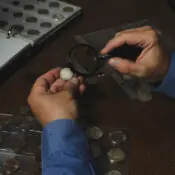
The Lobster Phone
Also referred to as the Aphrodisiac Telephone, the Lobster Telephone is a surrealist object created by Salvador Dali.
Dalí created 11 lobster telephones in the 1930s, all designed with a working rotary dial telephone and a lobster made of plaster. Four were painted red, and seven were painted white. At auction, in 2018, one sold for £853,000, (US$1,062,000). Dali’s sculpture is one of the most instantly recognizable pieces of Surrealism, the art movement that explored the world of dreams and the subconscious mind. The famous lobster phone series was established in 1936 specifically for an English poet known as Edward James, a leading collector of a bizarre kind of art. It was one of the hilarious objects spawned by the surrealist movement in the early 1930’s.
Geek out on surrealism below:
The Surreal art movement took shape in the early 1920s and aimed to explore the unconscious mind through irrational and dreamlike imagery. Surrealist art often features juxtapositions of seemingly unrelated objects and distorted reality, challenging the viewer’s perception of the world. Surrealism was an artistic and literary movement with Andre Breton known as the father of the movement. The visual artists who first prominently worked with Surrealist techniques and imagery was the German Max Ernst (1891–1976), the Frenchman André Masson (1896–1987), the Spaniard Joan Miró (1893–1983), and the American Man Ray (1890–1976).
Some additional well-known surreal artists are:
- Pablo Picasso (1881 – 1973)
- Max Ernst (1891 – 1976)
- Joan Miró (1893 – 1983)
- André Masson (1896 – 1987)
- René Magritte (1898 – 1967)
- Yves Tanguy (1900 – 1955)
- Salvador Dalí (1904 – 1989)
Dali was arguably the most well-known artist with this unique style. Here are some examples of his work: The Persistence of Memory, The Temptation of Saint Anthony, Still Life – Fast Moving



